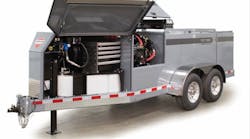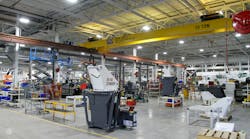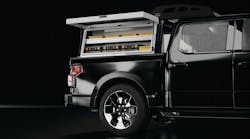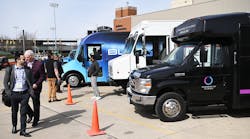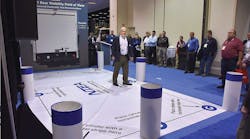Wtih the second phase of compliance with FMVSS 111 starting on May 1, Steve Spata and Susan Dehne took attendees on what Spata called an “enchanted journey” that would make the regulatory language easier to understand.
In their presentation, “FMVSS 111: How New Rearview Camera Requirements Affect Commercial Vehicles,” Spata, the NTEA’s technical assistance director, and Dehne, senior director of technical services, stressed the importance of vigilance.
“This is right on top of us,” Spata said. “You probably have received a lot of communications on this.”
That’s because the National Highway Traffic Safety Administration (NHTSA) issued a final rule for rear visibility that was mandated by Congress under the Cameron Bulbransen Kids Transportation Safety Act of 2007, with the purpose of reducing the number of vehicle backover incidents by requiring greater rear visibility.
The Cameron Bulbransen Kids Transportation Safety Act became public law in February 2008 and required NHTSA to revise the federal standard for rearward visibility, specifically to reduce backing crashes involving children and disabled people.
Spata said traditional mirrors have the inherent problem of not being able to see directly behind the vehicle. A 2003 Australian study showed that a 23½-inch-high cylinder would not be visible to an average male driver.
A Notice of Proposed Rulemaking (NPRM) was issued on March 4, 2009, after NHTSA research found 292 fatalities and 18,000 injuries (3000 of which were judged to be incapacitating) resulting from backovers every year. Of those, 228 fatalities and 17,000 injuries were attributed to backover incidents involving passenger vehicles under 10,000 pounds.
An NPRM on December 7, 2010, referred application to all vehicles with a GVWR of 10K pounds or less, except motorcycles and trailers. NHTSA said it was proposing to specify an area immediately behind each vehicle that the driver must be able to see when the vehicle’s transmission is in reverse. NHTSA wrote, “It appears that, in the near term, the only technology available with the ability to comply with this proposal would be a rear visibility system that includes a rear-mounted video camera and an in-vehicle visual display.”
On April 7, 2014, NHTSA announced an adjusted phase-in schedule from the NPRM and finalized the test procedure.
The new rear visibility regulation is chunked into two main areas of performance requirements: image parameters; and field of view (FOV).
The new performance requirements are: field of view, image size; response time; linger time; deactivation; default view; and durability.
Although FOV and image size are intertwined in regulation verbiage, only FOV compliance is required in the near term.
FOV phase-in compliance began for 10% of production vehicles on May 1, 2016, with exclusions applying. Effective May 1, 2017, FOV compliance will be required for 40% of production, with exclusions. Effective May 1, 2018, all aspects of FOV will apply to 100% of vehicles.
The following vehicles do not need to meet FOV requirements between May 1, 2017, and April 30, 2018:
• Vehicles manufactured by small manufacturers or limited-line manufacturers.
• Vehicles manufactured in two or more stages before May 1, 2018.
• Vehicles originally compliant with FOV and altered before May 1, 2017.
However, vehicles previously certified as meeting FOV requirements before May 1, 2017, and altered on or after May 1, 2017, must continue to meet FOV requirements.
One hundred percent of vehicles manufactured on or after May 1, 2018, with a 10,000-pound or less GVWR must meet as aspects of FMVSS 111 rear visibility: field of view, image size; response time; linger time; deactivation; default view; and durability.
Rear vision system requirements:
• S6.2.3 Response time. The rearview image meeting the requirements of S6.2.1 and S6.2.2, when tested in accordance with S14.2, shall be displayed within 2.0 seconds of the start of a backing event.
• S6.2.4 Linger time. The rearview image meeting the requirements of S6.2.1 and S6.2.2 shall not be displayed after the backing event has ended.
• S6.2.5 Deactivation. The rearview image meeting the requirements of S6.2.1 and S6.2.2 shall remain visible during the backing event until either the driver modifies the view or the vehicle direction selector is removed from the reverse position.
• S6.2.6 Default view. The rear visibility system must default to the rearview image meeting the requirements of S6.2.1 and S6.2.2 at the beginning of each backing event regardless of any modifications to the field of view the driver has previously selected.
• Durability. The rear visibility system shall meet the field of view and image size requirements of S6.2.1 and S6.2.2 after each durability test specified in S14.3.1, S14.3.2, and S14.3.3.
• S6.2.2 Size. When the rearview image is measured in accordance with the procedures in S14.1, the calculated visual angle subtended by the horizontal width of all three test objects located at positions A, B, and C specified in S14.1.4 shall average not less than 5 minutes of arc; and each individual test object (A, B, and C) shall not be less than three minutes of arc.
• Field of view. Reverse guideline overlays in monitor must not cover test objects. Compliance assessments involve proper setup of the test area. Use grid, tarp, etc., to position test objects. Compliance assessments involve proper setup of the test area. Compliance assessments involve: vehicle preparation; tire pressure; fuel ballast; occupant ballast; and driver’s seat positioning.
Spata said FOV compliance can be maintained by:
• Keeping the rearview camera in the OEM-production location (as received). “Even if you have to remove it, if you put it back where it started, you’re at least in the ballpark.”
• Relocating the camera, if necessary to accommodate bodies and equipment, to a new, compliant location where it can have a proper field of view.
Potential compliance challenges:
• Box removal and other altered vehicle modifications beginning May 1, 2017. “With rear camera systems today, a lot of them are in the latch of the tailgate. That one in particular is going to be something you have to wrestle with. You have to put a new camera on, but it has to be one that is compliant. So obviously moving the camera can affect the field of view. It doesn’t mean it can’t comply. It just means it’s a question mark until you can verify it.”
• Moving the camera could affect FOV and image size until May 1, 2018. “If you think about a fisheye lens, if you move that around you could get the distortion effect where you could end up squishing the cylinders, which are the ones that determine image size. If those farthest cylinders end up getting squished and damaged, you don’t know if it’s going to meet requirements or not. But it’s definitely affected.”
Equipment-related performance requirements:
• NHTSA is not requiring system suppliers of camera monitor systems to certify the equipment, so ask for compliance statements for the systems you purchase. “That’s a little bit of a departure from what they typically do with any of the other equipment-related standards. For example, lighting. If you have a stop lamp, there’s a code on the lenses that tells you from the manufacturer that it’s been certified by them, so you meet all performance requirements. Pretty similar are tires, wheels, seat belts, brake lines—they all have certification from the manufacturer that tell you they are representing the performance requirements of the standards they are associated with. We suggest you work with camera system manufacturers and OEMs.”
NTEA recently released a test manual and kit to provide guidance in meeting the FOV requirements.
“The new rear visibility regulation that takes effect later this year and next has widespread implications for the work truck industry,” said Steve Carey, NTEA executive director. “NTEA’s test manual and kit are designed to assist companies with demonstrating conformity to the new field of view requirements.”
To help equipment manufacturers, distributors and upfitters better understand the rules and identify potential rearview camera relocation needs, NTEA’s Rear Visibility FMVSS 111 Field of View (Rearview Camera) Conformity Manual provides detailed information, including a materials list, step-by-step test procedures, and a testing procedure check list.
The kit includes a tarp with the necessary markings to facilitate test cylinder placement; tape to properly mark test cylinders; and a Manual for guidance in locating the camera for proper field of view.
Visit Shop NTEA to order a kit (includes tarp, tape and manual) for $499 member, $649 non-member. Manuals can be purchased separately ($199 member, $299 non-member). ♦
